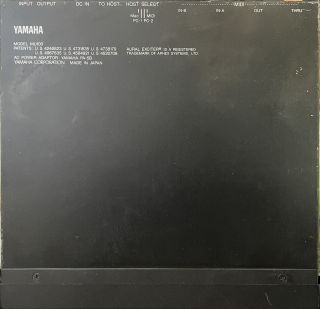Yamaha MU100
 |
|
| W × H × D (mm) | 220 × 44 × 210 (MU100)[1] 483 × 44 × 229 (MU100R)[2] |
|---|---|
| Rack units | 1U, half-width (MU100) 1U, full-width (MU100R) |
| Weight | 1.3kg (MU100)[1] 2.4kg (MU100R)[2] |
| Type | GM/XG sound module |
| Manufacturer | Yamaha |
| Release date | 1997[3][4] |
| Standards | General MIDI Yamaha XG[1][2] TG300B mode[1][2] C/M mode[1][2] |
| Parts | 32 normal parts[1][2] 2 A/D parts[5][6] |
| Max polyphony | 64[1][2] |
| Normal presets | 1267 (total)[1][2] 1074 (XG)[1][2] 614 (TG300B)[1][2] |
| Drum presets | 46 (total)[1][2] 36 (XG)[1][2] 10 (TG300B)[1][2] |
| Expansion | 1× PLG (MU100) 2× PLG (MU100R) |
| Effects | Reverb (12 types)[1][2] Chorus (14 types)[1][2] Variation (70 types)[1][2] 2× Insertion (43 types)[1][2] Multi EQ (4 types)[1][2] Part EQ (1 type)[1] |
| ← Yamaha MU90 | |
| Yamaha MU128 → | |

The Yamaha MU100 and Yamaha MU100R are Yamaha XG and General MIDI sound modules in the Yamaha MU series introduced by Yamaha in 1997.
The MU100 and MU100R improve upon the preceding MU90 and MU90R by almost doubling the number of preset normal XG instruments, and adding a further 16 drumkits, more effect types, and per-part EQ (complementing the existing global EQ). They also introduce the XG Plug-in System of optional expansion boards, which can add additional types of synthesis or effects to the synth.
Because the MU100 and MU100R overhaul the basic set of XG sounds, they also introduce a "voice map" concept that allows switching between "MU Basic" (MU50/MU80/MU90) and "MU100Native" versions of GM1/"capital voice" instruments,[7][8] improving compatibility with old song data. This is similar to the "sound map" concept on the Roland SC-88 and later. MIDI data for the MU100 and MU100R can specifically request the "Native" and "Basic" versions of GM1 instruments by using the Bank Select LSB values 126 and 127 respectively.[9][10]
As with their immediate predecessors, the MU100 is a half-width desktop module, whereas the MU100R is a full-width rack-mount version. There are three main additions in the MU100R versus the MU100:
- The MU100R has additional audio outputs that parts can be individually routed to.
- The MU100R has two plug-in board connectors (so two plug-in boards can be installed), whereas the MU100 only has one.
- The MU100R in its factory configuration has the PLG100-VH (vocal harmony effect) and PLG100-VL (virtual analog synthesis) plug-in boards pre-installed, unlike the MU100. Although the manual documents these as if they are an integral part of the unit, these boards can be removed or replaced with other plug-ins,[11] so it is unfortunately not certain that a MU100R bought used will still have these.
References
- ↑ 1.00 1.01 1.02 1.03 1.04 1.05 1.06 1.07 1.08 1.09 1.10 1.11 1.12 1.13 1.14 1.15 1.16 1.17 1.18 Yamaha MU100 Owner's Manual, pages 173 and 174.
- ↑ 2.00 2.01 2.02 2.03 2.04 2.05 2.06 2.07 2.08 2.09 2.10 2.11 2.12 2.13 2.14 2.15 2.16 2.17 Yamaha MU100R Owner's Manual, pages 181 and 182.
- ↑ MU100 - Display Collection - INNOVATION ROAD - Yamaha Corporation
- ↑ MU100R - Display Collection - INNOVATION ROAD - Yamaha Corporation
- ↑ Yamaha MU100 Owner's Manual, page 19.
- ↑ Yamaha MU100R Owner's Manual, page 4.
- ↑ Yamaha MU100 Owner's Manual, page 147.
- ↑ Yamaha MU100R Owner's Manual, page 160.
- ↑ Yamaha MU100 Sound List & MIDI Data, pages 73 and 83.
- ↑ Yamaha MU100R Sound List & MIDI Data, pages 83 and 97.
- ↑ MU100R - Installing and Accessing PLG Cards (Yamaha FAQ article)
External links
- Yamaha MU100 Owner's Manual
- Yamaha MU100 Sound List & MIDI Data
- Yamaha MU100R Owner's Manual (includes documentation of VH and VL cards)
- Yamaha MU100R Sound List & MIDI Data (includes documentation of VH and VL cards)